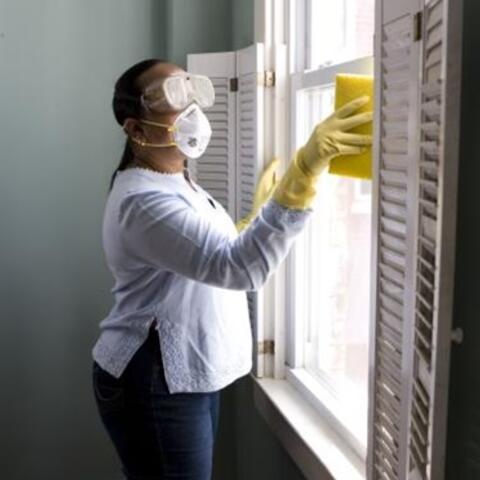Flooding: Cleaning Up Your Home After a Flood
The following outlines the steps you should take to protect yourself and your family as you clean up after a flood. Please contact your local health department for additional information or questions.
Before you begin: When returning to your home after a flood, be aware that flood water contains contaminants, such as sewage. Sharp objects, debris, and other safety hazards that may have been washed into the area by flood waters. Before entering to clean an area, make sure the building is structurally safe and that the electrical service has been inspected and is safe to use. Also, be sure that all gas appliances are inspected and approved for use.
Gather cleaning tools such as buckets, mops, trash bags, cleaning rags, ammonia-free household cleaner, laundry detergent, dish soap, measuring cups, and household bleach (5% chlorine).
Set up a handwashing area for handwashing throughout the cleaning process. For rinsing hands, use water that has been boiled for 1 minute, or make a solution of ¼ teaspoon of household bleach per 1 gallon of water.
Protect yourself and your family during cleaning.
- Keep children and pets out of the affected area until cleanup has been completed.
- Wear protective equipment, including rubber boots, rubber gloves that cover most of the arm, disposable coveralls, N-95 face mask (respirator), and eye protection.
- Wear earplugs or protective headphones to reduce risk from equipment noise.
- Seek immediate medical attention if you become injured or ill.
Inspect the building.
- Stay away from damaged buildings or structures until they have been inspected for structural safety.
- Wait to return to buildings during daylight hours, when it is easier to avoid hazards, particularly if the electricity is off and you have no lights.
- Check and clean heating, ventilating, and air-conditioning systems before use.
- Fix any water leaks.
- If using an onsite private sewage system, your system must be inspected and serviced prior to using an in-home washing machine.
Remove contaminated items that cannot be cleaned/salvaged.
Items that cannot be washed and disinfected may have to be removed and disposed of if they were contaminated with sewage or flood waters. This includes:
- Drywall
- Insulation
- Mattresses
- Carpeting
- Carpet padding
- Rugs
- Upholstered furniture
- Cosmetics
- Stuffed animals
- Baby toys
- Pillows
- Foam-rubber items
- Books
- Wall coverings and most paper products, as they cannot be properly disinfected
Never mix bleach and ammonia, or bleach and acids. This creates toxic gases that are dangerous and can cause serious injury.
- Help the drying process by using fans, air conditioning units, and dehumidifiers.
- To clean hard surfaces that may have been in contact with floodwater (such as flooring, concrete, molding, wood and metal furniture, countertops, appliances, sinks, and other plumbing fixtures): First, wash with a household cleaner (non-ammonia) and clean water. Next, disinfect with a mixture of 1 cup of bleach in 5 gallons of water. Allow to air dry.
- To remove observed mold: Mix 1 cup of bleach in 1 gallon of water, wash the item with the bleach mixture, scrub rough surfaces with a stiff brush, rinse the item with clean water, then allow to dry.
- To wash clothing: Wash any clothes contaminated with flood or sewage water (including clothes worn during cleanup) in hot water and laundry detergent. It is recommended that a commercial laundromat be used for washing large quantities of clothes and linens. Wash contaminated clothes separately from uncontaminated clothes and linens.
Additional precautions when cleaning around /outside the residence.
- Wash Your Hands Regularly! After all cleanup activities, be sure to wash your hands to avoid ingesting bacteria and viruses, other waterborne diseases, or hazardous materials. Use alcohol-based gel hand sanitizer after thoroughly washing hands.
- Avoid smoking or using open flames until you are assured that all gas utilities, appliances, and fixtures are in proper working condition.
- Have at least one fire extinguisher, with a UL rating of at least 10A, at every cleanup job.
- Use teams of two or more people to move bulky objects. Avoid lifting any material that weighs more than 50 pounds (per person).
- When using a chain saw, operate the saw according to the manufacturer's instructions, wear appropriate protective equipment, avoid contact with power lines, be sure that bystanders are at a safe distance, and take extra care in cutting trees or branches that have gotten bent or caught under another object.
- In hot weather, try to stay cool by taking breaks in shaded areas or in cool rooms, drinking water, and wearing light and loose-fitting clothing when not engaged in cleaning and sanitizing. Do outdoor activities during cooler hours.
- Dispose of debris, tree limbs, furniture, mattresses, and large or bulky items following instructions provided by your local community leaders.
Contact your local health department for additional information or questions.


